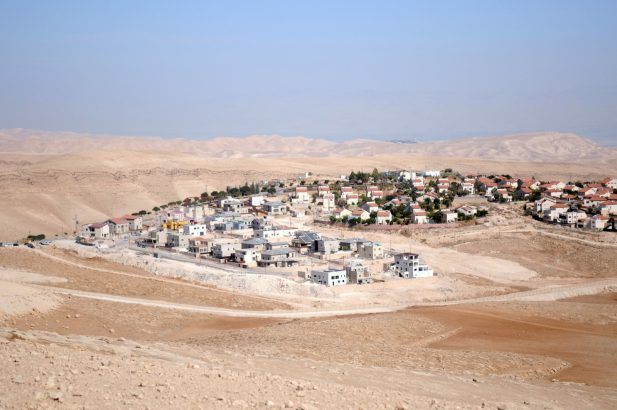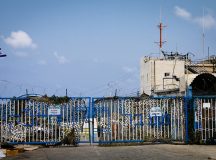After 50 years of Israeli control over the West Bank, increasing numbers believe that a ‘two states for two peoples’ solution to the Israeli-Palestinian conflict is impossible. These pessimists point to the total lack of trust between the two parties and the supposed irreversibility of the settlement enterprise, with some 590,000 people now living beyond the former 1949 armistice or Green Line. In this article, Blue White Future co-chairmen Gilead Sher and Orni Petruschka argue that while the obstacles are undoubtedly formidable, neither is insurmountable. The two-state solution is in political trouble but it is still achievable and imperative to the respective parties.
Lack of trust or lack of creativity?
The lack of trust between Israelis and Palestinians originates primarily from repeated failures reaching signed agreements and subsequently implementing them, combined with varying levels of violent confrontations. The more the parties fail, the more they blame the other side, and trust declines still further. Each failure means the next round of talks begins from an even lower point. Between and during negotiations extremists and spoilers on both sides do their utmost to erode trust still further, sabotaging any progress, through terrorism, incitement and other actions.
The only way to exit this vicious cycle is to employ a different paradigm, one that is not based solely on bilateral negotiations towards a comprehensive agreement and thus does not require mutual trust as a necessary condition for progress.
The reason for changing the process is to lower the bar. Currently it is set too high: the achievement of a fully-fledged Permanent Status peace agreement. As in a high-jump competition, we need to set the bar at a lower level and only after it has been cleared, should we raise it progressively.
A more realistic target is a ‘divorce’ two-state agreement between the parties, focused on phased separation between the sides and an absence of violence. But even that level is currently still too ambitious, as was proven in the Camp David and Taba talks in 2000-2001 and in the Annapolis process in 2007-2008. Instead of moving towards an agreement to two states, we need to define our goal as moving towards a reality of two states, and to advance gradually towards that goal.
This approach consists of constructive steps that each side can take, independently of the other, in order to advance a situation – both on the ground and in the political realm – which is closer to two states. This paradigm calls for an increased role of the international community, which should provide a clear vision of the final end goal of an agreement – along the lines of the recent John Kerry six-point speech – and of the ways it will benefit both parties. In addition, the international community should also push the parties to make independent progress towards that destination. In other words, a continuous process that comprises transitional stages while moving steadily in the right direction should be initiated, facilitated, and supported. The respective independent steps should not be considered an exclusive route but rather a complementary – and eventually alternative – component within the context of regional and bilateral negotiations.
Constructive independent steps
What would such constructive independent steps towards a reality of two states look like? On the Palestinian side it would involve building governmental institutions of the future Palestinian state; curtailing any incitement within their educational and political systems; working towards a fully functioning democracy which includes all factions that denounce violence; and applying for recognition as a fully-fledged member-state of the UN – a move which should be embraced by Israel and the international community.
On the Israeli side, one constructive independent step would be to announce that it has no claims of sovereignty outside of the main settlement blocs and to the east of the security barrier i.e. on an area that totals approximately 90 per cent of land the West Bank. Such a statement would carry much more significance than a temporary settlement freeze because it would result in a de-facto cessation of settlement activity in the relevant remote areas outside the blocs.
Cessation of settlement activity outside the settlement blocs would restore sincerity to Israel’s discourse about the two-state solution. Furthermore, it would convey a crucially important message to the settlers who live in these areas that their current place of residence will eventually not be part of the State of Israel. Such a policy would also immediately require the government to compensate the settlers and offer to relocate them to ‘Israel proper’. Hence, the statement that Israel is relinquishing any long-term territorial claims of sovereignty over the areas located outside of the settlement blocs will necessitate enacting a law that enables voluntary relocation and includes considerable compensation for the settlers.
The demographics of the settler community
Voluntary settler relocation brings us to the second obstacle to a two-state solution, which is the presence of the many settlers beyond the Green Line. The erroneous perception is that since it will not be possible to evacuate approximately 590,000 settlers, an agreement cannot be reached. But failing to make a differentiation between the main blocs and the more isolated settlements ignores both the exact areas in which the settlers reside and the trends within the settler community.
Let’s start with the actual numbers. The approximately 590,000 Jews living beyond the Green Line can be divided into three groups. The first group is the approximate 200,000 Israelis who live in the 12 Jewish neighbourhoods of East Jerusalem, which will undoubtedly remain under Israeli sovereignty in any agreement. The second group is some 300,000 settlers who live in the so called ‘settlement blocs,’ located west of the security barrier which are usually very close to the Green Line. The vast majority of these settlements are also likely to remain under Israeli sovereignty.[1] Only the third group, comprising 90,000 settlers – less than 20 per cent of the entire population of those living beyond the Green Line – who live beyond the route of the security barrier, needs to be addressed at the present time. These numbers are significantly fewer than the supposedly prohibitive numbers that are often quoted and regarded as an insurmountable obstacle.
Yet even this third group of 90,000 is far from being homogeneous. It includes far-right ideological settlers, secularists who moved from the kibbutzim in search for a better ‘quality of life’, and non-nationalist Ultra-Orthodox families who moved beyond the Green Line for cheaper housing. The group varies geographically, with most settlers on the mountain range – from central Samaria to the central part of the Judean mountains – being more ideological, whereas those in the Jordan valley, in northern Samaria and the southern Hebron mountains being less ideological. And it also varies in its approach to the two-state solution and the prospect of settlement evacuation, with some contemplating violent resistance while others actively seeking peaceful voluntary relocation.
How Settlers relate to voluntary evacuation and compensation
In a 2013-14 poll conducted by Blue White Future and the Macro Center for Political Economics, we found that within the Jewish population living beyond the security barrier (i.e. those of the third and supposedly problematic group) 28.8 per cent of settlers would accept compensation and relocate to ‘Israel proper,’ even before a permanent agreement is reached. This number is likely to grow once this option becomes a realistic alternative. Unsurprisingly, this figure is higher within the secular settlements of the Jordan valley and southern Hebron Mountains, where 43.1 per cent would accept compensation and relocate.
These findings underscore the need to enact a voluntary compensation and relocation law, which will enable those settlers who wish to relocate to do so, of their own accord. It will not only reduce the number of settlers in the West Bank and thus ease the burden of evacuation if and when the need arises in the context of an agreement, but it also represents a humane act that takes into consideration the difficulties suffered by these settlers. It would considerably reduce the personal, communal, societal and national trauma.
Another interesting finding of the poll is that the older age groups are more supportive of a voluntary relocation and compensation law, with 46.5 per cent of people aged 50-59 supporting it. Many of these settlers moved to their homes in the 1970s and 1980s, when a totally different security, political, regional and diplomatic reality governed the territories. They now find themselves at a fairly advanced stage of their lives without their children – who often prefer not to stay in these settlements – and lack proper health services and other old age facilities. In a way, they are paying a price for the government’s indecision about the status of the territories and the resulting lack of investment in old age facilities.
It is the responsibility of Israeli society to recognise this reality and allow the settlers who so wish to rebuild their lives within boundaries, albeit provisional, that encompass the democratic nation-state of the Jewish people. It is the government’s responsibility to create the conditions that will allow them to relocate in a dignified and respectful manner that takes into consideration their current needs.
National preparedness for settler absorption
Once a negotiated Israeli-Palestinian agreement is reached, it will inevitably require finding a solution not only to the roughly 30 per cent of settlers living beyond the security barrier who wish to relocate today, but to the rest of the approximately 90,000 settlers in that group as well. Although such an agreement may allow some settlers to remain within the borders of a Palestinian state, it should be assumed that most of the remaining settlers will prefer to relocate to Israel, albeit grudgingly.
An important aspect to consider sooner rather than later is a housing plan for these settlers within ‘Israel proper’ (including within those settlement blocs which will likely remain under Israel’s sovereignty as part and parcel of its territory). Given the housing crisis in Israel, it is imperative that the government prepare a national plan for absorption of the settlers, so that the failures of housing arrangements after the 2005 Gaza disengagement will not be repeated. Like every other citizen, the settlers are concerned about house prices, employment, and essential social services.
A 2011 study conducted by Blue White Future on the availability of future housing for relocated settlers found that if the government accelerates a few infrastructure-related projects, the expected supply of housing can meet and even exceed the requirements. We therefore encourage the government to update that study and to implement its findings in order to open up an abundance of housing solutions.
Public legitimacy
Finally, the hard-line, ideological settlers will accept an agreement and evacuate more peacefully if they believe that this is the genuine collective will of Israeli society. It is therefore important that any decision regarding settlement evacuation enjoys wide public legitimacy, and will not be based on a narrow majority in the Knesset.
It is preferable that the mechanism to approve the relocation of settlers following a comprehensive agreement should be based on a public referendum or on a clear majority of the Knesset. From the work Blue White Future has done within the settlements themselves, we have learned that wide public legitimacy will enable the ideological groups to make the case that the unity of the ‘people of Israel’ is no less important than the unity of the ‘Land of Israel,’ and that respecting the will of the people – as reflected by a clear majority – justifies compromising on their hard-line ideology.
It is both wrong and counterproductive to treat the settlers as obstacles to peace. Rather, Israeli society should regard them as pioneers or emissaries, whose mission has been accomplished, and who should thus be welcomed back and compensated accordingly. It is the duty of Israeli society and its leadership to ensure that the aspirations of the settlers are treated humanely and be met in a dignified manner.
Summary
This year marks 100 years from the first international acceptance of Zionism in the form of the Balfour Declaration, 70 years since the UN partition resolution, and 50 years since the Six-Day War in which Israel – defending itself – conquered and subsequently occupied the West Bank. While the end of the Israeli-Palestinian conflict seems remote, careful analysis of the two major obstacles suggests that they can and should be overcome. Lack of trust can be circumvented by the adoption of a new paradigm – one that calls for constructive, independent steps towards a clear vision. The issue of settlements is perceived as a more formidable problem than it actually presents, and can be further reduced by careful and considerate treatment of the settlers.
Peace is possible. It requires political action and public engagement, internal dialogue within respective societies, building bridges from within, preparation of hearts and minds for a compromise and an indispensable paradigm shift. The despair regarding the chances to resolve the conflict is therefore unjustified, as smart, courageous yet careful leadership, as well as a candid internal dialogue, can achieve a breakthrough. As former Irish Prime Minister, Bertie Ahern said: ‘We can always go back to killing each other.’ It is time for a balanced and graduated political initiative that would be consistent with Israel’s long-term interests: ensuring the nation’s future as the secure, democratic nation-state of the Jewish people.
[1] According to a more conservative definition of the blocs which the Palestinians are more willing to accept in the context of territorial swaps to reach an agreement, the number of settlers residing in blocs is lower, numbering approximately 240,000. However for the interim steps and recommendations suggested in this article, which advance a two state reality, we have used an Israeli perspective on what constitute settlement blocs.






































I applaud the constructive, optimistic nature of this article. There is far too much negativity and cynicism surrounding this conflict, so attitudes such as what is being expressed here, are welcome and refreshing.
However, I do have some issues with this particular proposal, namely, 1- that Israel would end up absorbing all the land within the “security barrier”, and, 2- that all the settlers (around 90K) beyond the security barrier, would have to be relocated. The problem I see with 1, is that this implies that Israel would effectively be appropriating all that land (within the security barrier) that those settlements were built on, which the Palestinians may not be all that happy about giving up (and hence, they might not be willing to agree to this…) And the problem with 2, is that relocating tens of thousands of people is no easy feat (easier than hundreds of thousands, sure, but still, a rather daunting challenge).
Thus, I’d like to present an alternate proposal. Yes, I acknowledge it’s somewhat unconventional, but considering how long this conflict has dragged on, with not a whole lot of success with any of the current thinking, I feel it’s high time for all parties involved to be more receptive to nonstandard approaches. I outline the plan here- http://sandra-llap.rhcloud.com/peace-sells/states/ , but the gist of it is that Palestine would encompass the entirely of the West Bank, including all the settlements, and the Jewish residents of those settlements would not be forced to evacuate, but rather would be allowed to remain as citizens of the newly formed Palestinian state (or they would also have the option to move back to Israel, if the wished to remain citizens of Israel). The assumption implicit in the Petruschka/Sher proposal, is that the Palestinians would not accept for there to be ANY Jews living in the state of Palestine. However, if their hostility and intolerance towards Jews is *that* high, that they would rather have less land than have the land with the Jews in it, then I have to wonder as to the prospects for a stable, lasting peace between the Israelis and Palestinians. Again, I acknowledge that what I’m suggesting is not something which is commonly considered at the present time, but I don’t seem to be entirely alone in my views, as I just recently happened to discover this- http://2states1homeland.org/en , which seems to be in a very similar vein.
A different, democratically elected Israeli administration might eventually declare, as a measure of good faith, that Israel renounces any claim to sovereignty over territories conquered in 67′, except for the current settlement blocs. It would then be expected, at a minimum, that the Palestinian leadership declare as a reciprocal measure of good faith that a Palestinian state would not be Judenrein— that Jews will be welcome to live near their Holy sites under a Palestinian government. Hey, good luck with that…! Up to now the Palestinian leadership has boasted of any Israeli concession or gesture as a an advancement in the path to free Palestine from the river to the sea.
On the other hand, if the Palestinian leadership were to make such declaration in advance the picture would be rather different: Israel would be be compelled to reciprocate. And maybe things would start moving… the problem of the settlements as an obstacle to peace would prove to be a canard.
Why no mention of the critical landmark of the 1922 Mandate for “Palestine”?
It was binding and more important than the 1947 partition recommendation.
It defined the boundaries of the evolving Jewish nation-state to encompass all of Judea and Samaria, including, obviously, all of Jerusalem. Some people might not like to hear that, but it is a fact.
In 1967 Israel did not “conquer and occupy” anything; it liberated the heart of the Jewish National Home from illegal Arab occupation.
The above is not music to the ears of the anti-Zionist extremists, nor the naive wishful thinkers, but it is the truth.